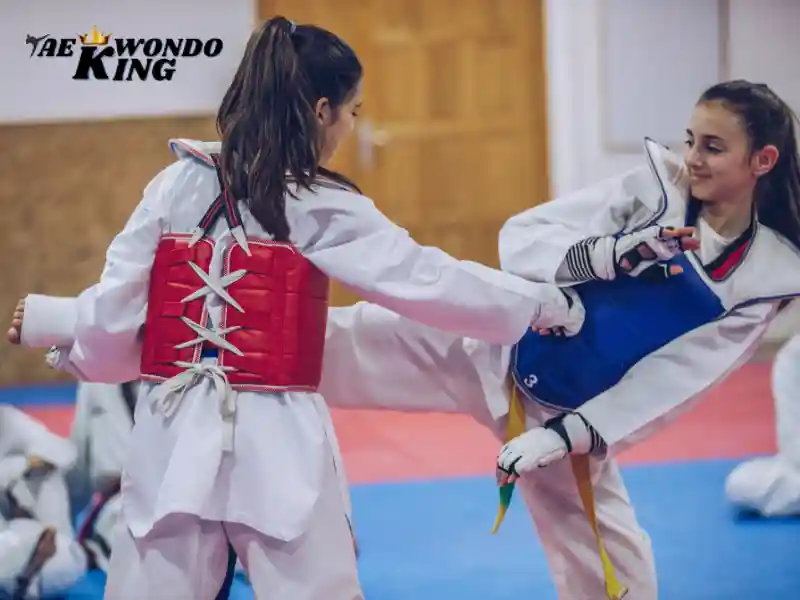
As a 3rd Dan black belt, national and international competitor, coach, and referee, Taekwondo has been my life’s passion. But like any martial art, Taekwondo has areas for improvement. Let’s delve into the weaknesses of Taekwondo, not to diminish its power, but to foster a well-rounded understanding of this dynamic discipline.
Weaknesses of Taekwondo:
Limited Focus on Ground Fighting:
Traditionally, Taekwondo emphasizes powerful kicks and strikes delivered while standing. While self-defense scenarios often involve grappling, Taekwondo offers a limited repertoire of ground-fighting techniques compared to Brazilian Jiu-Jitsu or wrestling.
Emphasis on Power Over Technique:
While power is crucial, some training methods might prioritize impactful kicks over flawless technique. This can lead to bad habits and leave practitioners vulnerable to agile opponents who exploit gaps in form.
Varied Quality of Instruction:
The quality of instruction can vary greatly between dojangs (training halls). Inconsistent teaching methods or unqualified instructors can hinder a student’s progress and potentially lead to improper technique or injuries.
Emphasis on Forms Over Sparring:
Forms (poomsae) are a valuable aspect of Taekwondo, developing focus and coordination. However, an overemphasis on forms at the expense of regular sparring practice can limit a student’s ability to adapt and react in real-time combat situations.
The Rigidity of Competition Rules:
WT GMS competition rules, while ensuring fairness, can sometimes restrict the full potential of Taekwondo techniques. Certain effective strikes or throws might be penalized, limiting the strategic options available to athletes.
Addressing the Weaknesses:
These weaknesses shouldn’t deter you from Taekwondo. Here’s how to address them:
Cross-Train:
Consider supplementing your Taekwondo training with classes in grappling-focused martial arts like Judo or Brazilian Jiu-Jitsu.
Seek Quality Instruction:
Find a reputable dojang with qualified instructors who prioritize proper technique alongside power.
Embrace Sparring:
Regular sparring practice hones your reflexes, timing, and ability to adapt to dynamic situations.
Maintain a Balance:
Utilize forms to develop focus and technique, but integrate regular sparring to bridge the gap between theory and real-time application.
Building a Well-Rounded Warrior:
We can elevate Taekwondo to its full potential by acknowledging these weaknesses and seeking solutions. Remember, Taekwondo is a lifelong journey of self-discovery and continuous improvement. Embrace challenges, explore complementary disciplines, and strive for a well-rounded understanding of self-defense.
Strengths of Taekwondo:
Powerful Kicks:
Taekwondo’s most iconic feature is its kicking techniques. Leg strikes are emphasized, making practitioners highly skilled in delivering powerful blows while maintaining distance.
Excellent Fitness:
Taekwondo training incorporates a full-body workout, improving cardiovascular health, flexibility, strength, and coordination.
Discipline and Focus:
Like many martial arts, Taekwondo heavily emphasizes respect, self-control, and mental focus. This translates into improved concentration and goal-setting skills.
Structured Learning:
Taekwondo follows a clear belt ranking system, providing a structured learning path with defined goals and achievements.
Considering Different Needs:
The “weaknesses” of Taekwondo might not be weaknesses at all, depending on your goals. If you’re looking for a fantastic workout that emphasizes kicking and improves discipline, Taekwondo is excellent. However, if self-defense against grappling is a top priority, you might consider a style incorporating more ground fighting.
Conclusion:
Taekwondo is a well-rounded martial art with a lot to offer. By understanding its strengths and weaknesses, you can decide whether it’s the right fit for you. If you’re interested in exploring further, consider talking to instructors from different martial arts schools to see what best suits your goals.
Frequently Asked Questions:
Does Taekwondo need strength?
Yes, strength is crucial in Taekwondo. While technique and skill are important, having physical strength and power can greatly improve a practitioner’s performance in this martial art. Strength training can enhance kicking power, speed, and overall athleticism, making it an essential part of a well-rounded Taekwondo practice.
What is Taekwondo’s benefit?
Taekwondo provides a variety of benefits, both for the body and the mind. It enhances physical strength, flexibility, and cardiovascular health, while also teaching discipline, focus, and self-confidence. In addition, it can be an effective form of self-defense and a way to relieve stress. These advantages make Taekwondo a popular choice for individuals of all ages.
What is unique about Taekwondo?
Taekwondo is a martial art that stands out due to its emphasis on kicking techniques, setting it apart from other martial arts. The sport focuses on high, fast kicks and fluid movements, making it dynamic and exciting to practice and watch. Additionally, Taekwondo incorporates both physical and mental discipline, promoting not only physical fitness but also mental strength and focus. The combination of these unique aspects makes Taekwondo a standout martial art in the world of combat sports.
How can I be a good Taekwondo student?
To become a good Taekwondo student, it is crucial to practice regularly and follow your instructor’s guidance. Focus on perfecting your form and technique, and continuously aim to enhance your skills. Show respect to your fellow students and honor the traditions of Taekwondo, while always giving your best effort during training sessions. Keep in mind that patience and dedication are essential for becoming a proficient and disciplined Taekwondo practitioner.
What does Taekwondo lack?
Taekwondo tends to lack extensive grappling and close-quarter combat techniques, with a focus on point-sparring rather than continuous fighting. This can be a disadvantage in self-defense situations that go beyond kicks and punches.
What are the 5 disadvantages of Taekwondo?
Here are 5 disadvantages of Taekwondo:
- Limited grappling: Less emphasis on groundwork and takedowns compared to other martial arts.
- Focus on point-sparring: This may not fully translate to real-world self-defense which is often less structured.
- Distance dependent: Techniques might be less effective in close-quarters combat.
- Varied school quality: Finding a good school with well-rounded training can be crucial.
- Injury risk: Like any physical activity, Taekwondo carries a potential for injuries, especially with kicking techniques.
Is Taekwondo safe for girls?
Yes, absolutely! Taekwondo is a safe and effective martial art for girls of all ages. It teaches self-defense, discipline, and physical fitness while also promoting confidence and self-esteem. With proper instruction and supervision, girls can participate in Taekwondo with minimal risk of injury. It’s important to find a reputable and experienced instructor who can create a safe learning environment for girls to thrive in their Taekwondo practice.
Is Taekwondo a safe sport?
Yes, Taekwondo is generally considered a safe sport when practiced under proper supervision and with the right safety measures in place. Like any physical activity, there is always a risk of injury, but with proper training and adherence to safety guidelines, the risk can be minimized. It’s important for participants to learn and practice proper techniques and to use protective gear when sparring or competing. Overall, when practiced responsibly, Taekwondo can be a safe and enjoyable sport.
Can Taekwondo be useful?
Yes, Taekwondo can be useful in several ways:
- Self-defense: Provides practical skills for protection and situational awareness.
- Fitness: Improves cardiovascular health, and builds strength and flexibility.
- Confidence: Mastering techniques boost self-belief and empower individuals.
- Discipline and Focus: Develops mental fortitude and the ability to concentrate.
- Life skills: Teaches goal-setting, perseverance, and respect for others.
- Community: Creates a supportive network of friends and instructors.
What is Karate’s weakness?
Karate’s weaknesses include:
- Limited ground fighting: Similar to Taekwondo, Karate primarily focuses on striking techniques while standing, offering a limited ground-fighting repertoire.
- Emphasis on power over continuous strikes: Some training methods might prioritize strong single strikes over combinations or continuous attacks.
- Varied instruction quality: Inconsistent teaching methods or unqualified instructors can hinder progress and lead to improper technique or injuries.
- Focus on forms over sparring: While forms are valuable, overemphasizing them at the expense of regular sparring can limit a student’s ability to adapt to real-time combat situations.
What is Muay Thai weakness?
Muay Thai’s weaknesses include:
- Limited ground fighting: Muay Thai focuses on striking while standing, offering fewer techniques for grappling on the ground.
- Less emphasis on head movement: Muay Thai stance leaves practitioners open to powerful punches or kicks if they don’t bob and weave effectively.
- Potential for injury: The reliance on powerful kicks can lead to injuries in the knees, shins, and ankles.

Founder, Owner, and CEO of TaekwondoKing.
He is one of the top 100 martial artists in the World and among the top 20 referees in Bangladesh.
Ehatasamul Alom is an esteemed Kukkiwon Certified Taekwondo 3rd Dan Black Belt with over 15 years of experience in this dynamic martial art. Born in Rajshahi, Bangladesh, Ehatasamul’s journey with Taekwondo began at the tender age of seven. His passion led him to compete at national and international levels, where he has bagged numerous awards and honors. He is also a member of the Taekwondo National Referee Panel.
With a Bachelor’s degree in Sports Science from the prestigious Rajshahi University, Ehatasamul has a deep understanding of the technical and scientific aspects of martial arts and some other martial arts.
In 2022, Ehatasamul created the “TaekwondoKing.com” blog to share his knowledge and Real experiences. His articles focus on Taekwondo training techniques, competition strategies, and the art’s rich history and philosophy. He also writes about the importance of mental fortitude and discipline, key aspects of his teaching philosophy. His goal is to inspire both beginners and seasoned practitioners worldwide through insightful and engaging content.
If you need any help, contact Ehatasamul Alom at any time.




